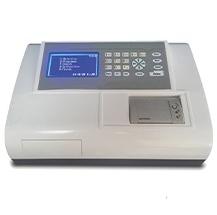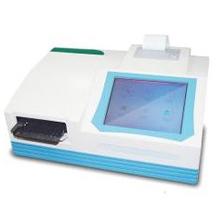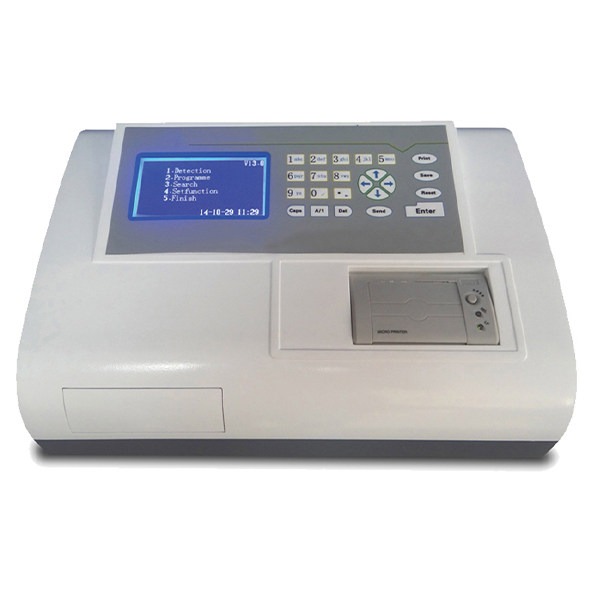The primary function of various types of microplate readers is colorimetric determination. The differences are in the determination wavelength range, absorbance range, detection speed, shock plate function, temperature control, quantitative determination software function, and other aspects, which are critical factors for choosing a microplate reader.

1. Determination of Wavelength for Choosing Microplate Reader
Generally, the determination wavelength of a microplate reader is between 400~750 nm and 800 nm, which can completely meet the color determination of ELISA.
At present, the common labeling enzyme is horseradish peroxidase (HRP). The substrate is usually tetramethylbenzidine (TMB) and o-phenylenediamine (OPD). In the presence of hydrogen peroxide solution, it is oxidized to diamino azobenzene (DAB) and benzoquinone by HRP.
When the pH value is about 5.0, DAB has the maximum absorption at 450 nm wavelength.
When the pH value drops to 4.0, the maximum absorption wavelength moves to 492 nm, and the molar extinction coefficient increases, the color rendering deepens. Therefore, strong acids such as sulfuric acid or hydrochloric acid are often used to terminate the reaction.
Benzoquinone, the oxidation product of TMB, has the maximum extinction coefficient at the wavelength of 450nm. If the amount of HRP is small, a blue cationic radical will be formed. By lowering pH, the blue cationic radical can be changed into yellow benzoquinone, and the product can be stabilized for 90 min by using sulfuric acid as a terminator.
450 nm and 492 nm are the most commonly used wavelengths for ELISA determination. Considering the need for dual-wavelength colorimetry, there should also be wavelength filters.
“Single wavelength” refers to the use of a wavelength of 450 nm or 492 nm for colorimetric determination with the maximum absorption of the color-developing device.
For “dual wavelength”, in addition to the wavelength with maximum absorption for color development, namely 450nm or 492nm, for colorimetric determination, the wavelength that is not sensitive to specific color development, such as 630nm, is also used for determination. The absorbance finally printed by the microplate reader is the difference between the two.
The absorbance obtained at 630 nm wavelength is non-specific and comes from the absorption caused by fingerprints, dust, dirt, etc. on the plate hole. Therefore, in the ELISA colorimetric determination, it is better to use dual wavelength.

2. Measured Absorbance Range for Choosing Microplate Reader
Generally, the absorbance measurement range of the microplate reader is between 0 and 2.5, which can meet the determination requirements of ELISA. Now it can reach more than 3.5 and can maintain better precision and linearity.
3. Detection Speed for Choosing Microplate Reader
The detection speed of the microplate reader refers to the time required to complete the colorimetric determination.
The detection speed is fast, which is beneficial to improve the detection precision, that is, to avoid the difference of absorbance between micropores due to different determination times during the determination process.
4. Shake Plate Function for Choosing Microplate Reader
The shake plate function of the microplate reader means that the instrument shakes and mixes the ELISA plate hole before the colorimetric determination to make the color in the plate hole uniform. Using the function, after the color reaction of ELISA determination is completed and the terminator is added, it can be directly put on the microplate reader without shaking and mixing.
5. Incubation Function for Choosing Microplate Reader
The incubation function means that the microplate reader itself can automatically and accurately control the internal temperature of the instrument as required, so that the incubation process of microporous Flat noodles in ELISA measurement can be completed inside the instrument, without the need for an external thermostat.
The incubation function is only an additional function of the microplate reader. Whether to choose a laboratory can be determined according to the conditions and needs of its own laboratory.
6. Software Function for Choosing Microplate Reader
The software function refers to the statistical analysis and reports results of ELISA qualitative determination and other measurement methods such as ultraviolet and agglutination.
The software function is a very important function of the medium and high-grade microplate reader.
If there is little difference in hardware, the software will become the only indicator to judge the quality of the microplate reader. For users, good software functions will be of great help to practical work.
For the qualitative determination of ELISA, if the microplate reader has the statistical calculation function of the positive judgment value “cut-off” and its determination “gray area” which means the measured absorbance is in a certain area around the cut-off, it not only facilitates the laboratory staff but also has high practical value in some specific circumstances.
It is better to have this curve regression equation calculation and analysis function in the software function of the microplate readers.
Related Products Recommendation

